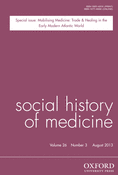-
Views
-
Cite
Cite
Christoph Gradmann, Sensitive Matters: The World Health Organisation and Antibiotic Resistance Testing, 1945–1975, Social History of Medicine, Volume 26, Issue 3, August 2013, Pages 555–574, https://doi.org/10.1093/shm/hkt018
Close - Share Icon Share
Abstract
The paper assesses the development of antibiotic resistance diagnostics after 1945. In the 1950s, demand for such testing led to the adaptation of procedures from experimental pharmacology and bacterial genetics to the needs of clinical microbiology. Further developments were influenced by stakeholders in clinical medicine, public health and industry. These changes are viewed through the lens of a 1960s World Health Organisation (WHO)-initiated research project, and the ways in which it developed over time. Driven forward by the Swedish medical microbiologist Hans Ericsson, this project attempted to frame resistance diagnostics in relation to the needs of public health, a standardisation of diagnostic tools and with regard to therapeutic rationalism. These objectives were swiftly combined with that of raising the professional status of clinical microbiology. Such aspirations, however, ran counter to industrial interest. Early in the 1970s standardisation instead remained confined to a single element in the diagnostic process: a small paper disc containing antibiotics. Ironically, Ericsson, who had pushed for a broader standardisation of diagnostic processes, ultimately found himself embarking on a career as a commercial producer of those discs.




